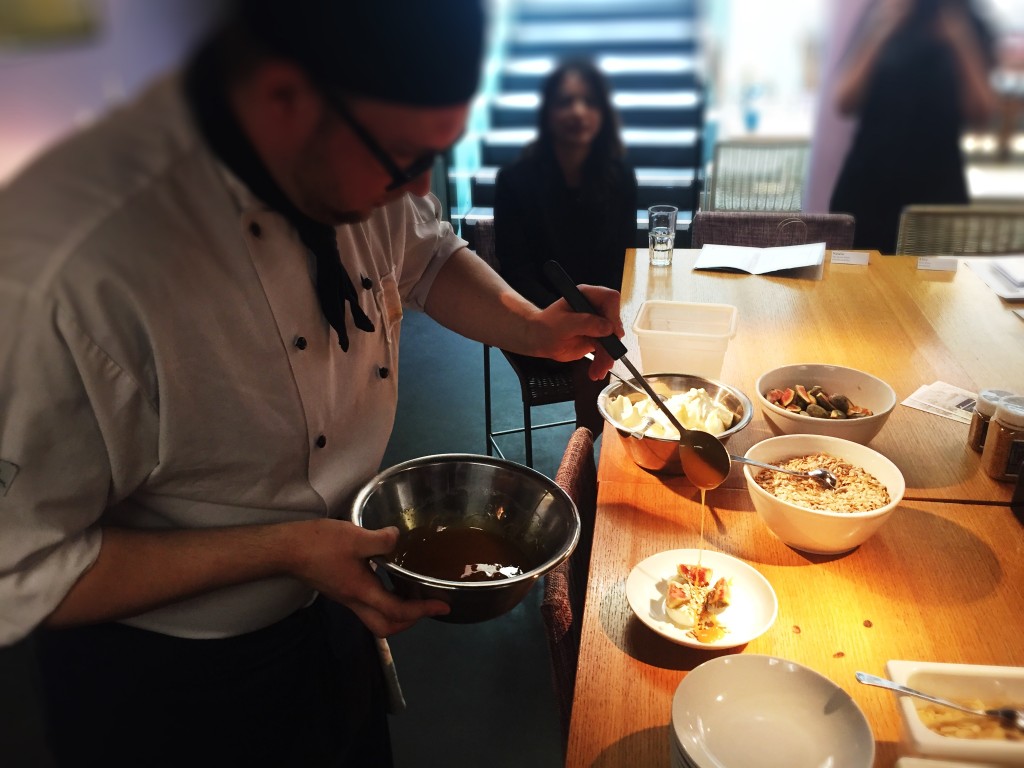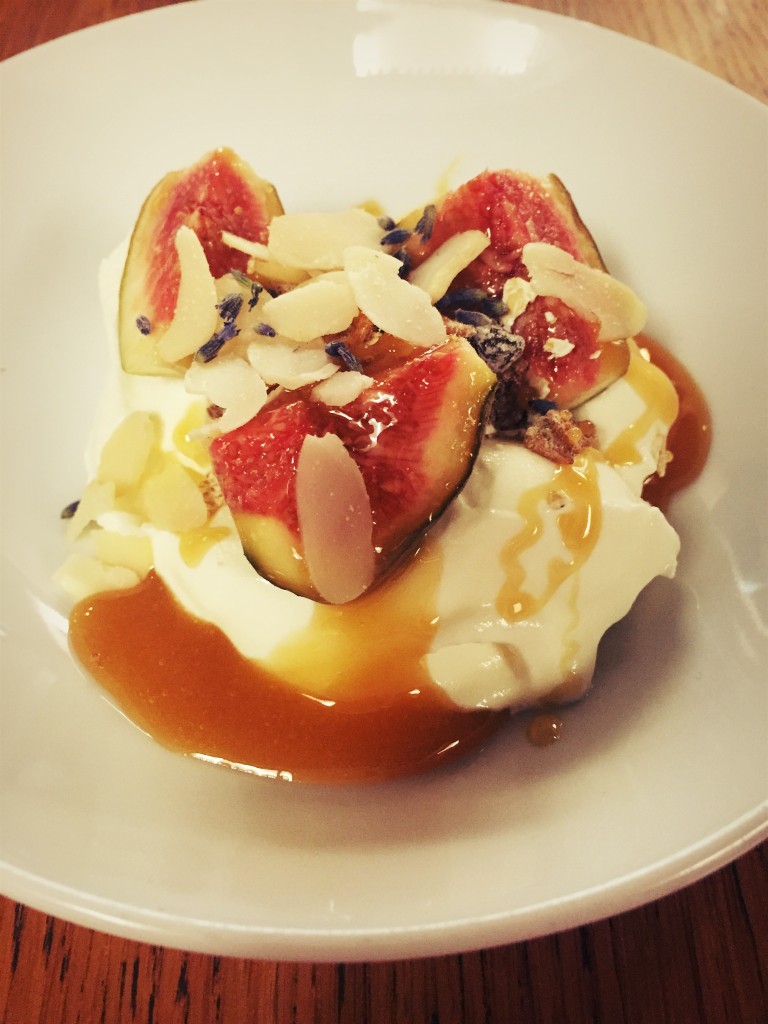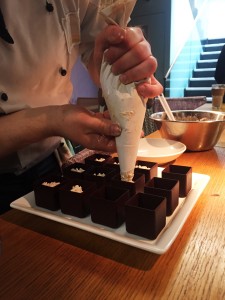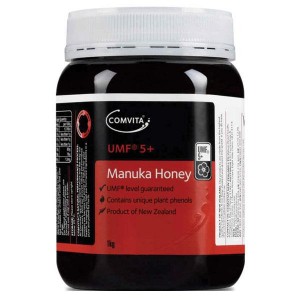We sent Beth Wells along to the heart of London to discover more about a certain ‘superfood’ – one that’s used by millions every day for their breakfast, in desserts and meals. But this type is thought to be the top pick and health-lovers pay a lot for it. What are we talking about? Manuka honey, of course.

Adding the final touches to the Comvita Get Sticky breakfast.
For many years I’ve been eating Manuka honey without really investigating what’s so special about it, so I was delighted to be able to attend the ‘Get Sticky at Brunch’ event hosted by Comvita at Tibits this morning.
Comvita is New Zealand’s leading producer of Manuka Honey, and adheres to strict quality guidelines. Many other UK suppliers have varying (and often bewildering) standards, putting the onus on the consumer to do the research. Comvita products are labelled with the UMF® trade mark, which denotes that it is traceable from hive to shelf, and is quality controlled. To be awarded the UMF® grading, honey must contain Manuka, and have the presence of DHA (dihydroxyacetone), leptosperin, and methylglyoxal. These scrabble board winners respectively act as a natural skin tanning (and therefore protection) agent, a natural chemical only present in Manuka (and therefore an indicator of its authenticity), and a detoxifier.
The discovery of Manuka honey was one of those happy accidents that turned into a success story. It was back in the 1970s when New Zealand farmers noticed that their cattle grazing on the Manuka flowers were much healthier than other cows, where this ‘weed’ wasn’t prevalent.
Investigation into the health benefits revealed that this unassuming plant had excellent prebiotic and antibacterial properties, helping wounds to heal more quickly, aiding indigestion, easing sore throats, and boosting overall immunity. Honey made from these flowers was therefore exceptionally beneficial, and since they only grow in New Zealand, and only flower for up to six weeks a year, it became highly prized.
Resident Tibits chef Leo demonstrated a number of dishes that can be made using this rare treasure. We started with a delicious breakfast of Greek yoghurt with muesli, fresh figs, flaked almonds, and a generous drizzling of Manuka honey.

Natural yoghurt with fresh figs, flaked almonds and honey.
The yoghurt was exceptionally light and fluffy, and, combined with the refreshing flavour of the figs, and the soothing warmth of the honey, it was a very welcome ‘feel good’ start to the morning. Muesli was used instead of granola so that the dish wasn’t too sweet, and I found the balance just right. We also had the option to sprinkle on some Comvita bee pollen, which added another level of delicate crunchiness.
Our next dish to sample was a dessert made from a coconut mousse encased in dark chocolate, with a honey drizzle. Despite my love of chocolate, I found this overpowering. The coconut mousse itself had a slightly granular texture that would have benefitted from some shaved coconut and perhaps some white and dark chocolate pieces instead of a whole case, to add variety to the texture. The honey combined well with the coconut – not a flavour pairing I would have normally considered.
Our final taster was a raspberry and blueberry smoothie, blended with a hearty dollop of the honey.
I’m a big fan of smoothies, so this was definitely a favourite! The unique flavour of Manuka honey really shone through here, and felt very soothing and warm on the throat. I wouldn’t normally have considered combining honey with acidic fruits like these, but it actually worked well, balancing the zingyness of the fruit with the mellow sweetness of the honey. Another ingredient you may add is Comvita’s Olive Leaf Extract. I didn’t sample this myself, but apparently it works well. Another use for this is to combine it with Comvita’s Apple Cider Vinegar to create a nutritious salad dressing.

Piping the coconut and dark chocolate dessert.
As well as these culinary delights, Comvita also make beauty products, since Manuka honey is equally beneficial when applied externally to the skin. I sampled the hand moisturiser, which was unscented, and quickly absorbed. Not only does Manuka honey moisturise the surface of the skin, but it also promotes growth of skin cells in the base layers, so the more you use it, the better the condition of your skin. It is recommended to use Manuka honey with a 10+ factor if you are applying it directly on the skin, to get the best antibacterial benefit. A face pack should be applied for twenty minutes to allow the honey to work, and draw out impurities.
 I found the event extremely informative and inspirational, and am certainly looking forward to experimenting with dishes of my own! In the past I have only served myself a spoonful of Manuka honey, in a very Mary Poppins medicinal way, but I’m now inspired to combine it with ingredients to create a whole variety of healthy treats. Remarkably, the healthy properties of Manuka honey are not destroyed by either light or heat. A lower grade is probably best for experimenting with hot food, as it is quite expensive.
I found the event extremely informative and inspirational, and am certainly looking forward to experimenting with dishes of my own! In the past I have only served myself a spoonful of Manuka honey, in a very Mary Poppins medicinal way, but I’m now inspired to combine it with ingredients to create a whole variety of healthy treats. Remarkably, the healthy properties of Manuka honey are not destroyed by either light or heat. A lower grade is probably best for experimenting with hot food, as it is quite expensive.
The most fascinating discovery for me today was that of bee pollen. I had seen jars of it before, but never tasted it, or even knew how you could possibly use it. These tiny beads are ‘harvested’ from the bees by making hive entrances smaller, and have a slightly bitter flavour and crispiness to them that would compliment all manner of desserts. They are packed full of vitamins, and the more colours in the pot, the wider the variety of vitamins incorporated.
Another image that will stay with me is that the hives are slowly moved from the North to the South Island as the flowers gradually bloom from area to area. I wonder how disorienting that is for the bees to wake up with a new vista, and have to choreograph a new dance for their colony!
Leave a Reply